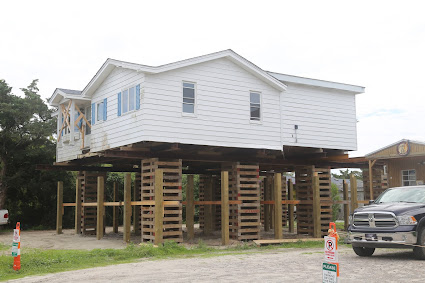Day 9
Wednesday, June 9
Unlike the trip the previous day, ferries from the north end of Ocracoke Island aren't by reservation. It's a free trip, but all first come, first served. The group I was hanging out with the previous night were all up and out for the first one of the day. I had purposely booked a place a half hour from the northern terminal, so I could spend more time here. Based on the first two ferries, I wasn't too worried about getting a spot on this one.
A couple of shots around Blackbeards Lodge...
After a short walk for breakfast, it was time to explore the island a bit. On the road in from the harbor, there's a sign for a British Cemetery.
In the early days of WWII, the HMT Bedfordshire was refitted with machine guns, a 4" gun and depth charges. The trawler was on loan to the U.S. from Britain for use in coastal defense. In May, 1942, it was torpedoed and sunk by a German submarine. The bodies of only four of he crew were recovered. They're buried here.
My next stop was the Ocracoke Island Light Station. Built here in 1824, it's the oldest lighthouse still operational in the state. There are only six parking spots on the street. But, considering the short walk and no interior access, turnover was fairly quick.
The Life Saving Church just up the street offers overflow parking for the lighthouse, as well as the trail to Springers Preserve. There's zero public parking for the reserve. The church just asks for a donation, and that you don't block the driveway.
The walk out to the Springers Preserve trailhead...
It's a pretty easy walk down a well cared for path to the beach at Springers Point.
Local legend has it, this was a favorite spot of Edward Teach, aka Blackbeard the Pirate. Later in life, he had all but retired in the town of Bath, up the Pamlico River.
He would still occasionally sail out, attack and plunder passing boats, then hide on the other side of Ocracoke Island. Eventually, the British Navy did catch up to him. There's a place off shore they still refer to as Teach's Hole. Not to be confused with the gift shop of the same name.
Seen in the lot adjacent to the church...
Back on the main road, there was one more spot I had to find. During WWII, the northern side of the island was used as a secret training base for what the Navy referred to as Beach Jumpers. Their job was deception. They were trained to quietly infiltrate create a diversion, and get out.
By now, it was time to think about some lunch. Which brought me to Howard's Pub and Raw Bar. Definitely an interesting place.
Driving north on Hwy 12, there's a parking area and a sign for the Pony Pen. These ponies are believed to have come ashore after a Spanish ship wrecked off the coast around 1565. When settlers arrived on the island around 1730, they were surprised to find the herd of wild horses.
The herd is down to thirteen and all decedents from the original horses. Instead of having free reign, they're now in a large pen. You can read more about them here.
Just a few miles north of the horses, is the pull of for the Hammock Hill Trail. It's a pretty easy loop trail and just under a mile.
Heading to the ferry...
The website was right. The ferry between Ocracoke and Hatteras Island is free and rides are plentiful. When you drive up, they separate you into loading lanes, and you wait. Fortunately, not very long.
I've seen all kinds of things loaded on ferries. But, I've never seen something quite like this...
Here's how often they run. On the trip over, three ferries passed headed the other way.
After disembarking, my first stop was the Cape Hatteras Light Station. We visited when I was a little kid. Dad and I tried to walk up the stairs inside to the top, but I only made it to the first window.
The first lighthouse was build here in 1803 and painted the color of sandstone. At ninety feet tall, it was quickly discovered it wasn't tall enough to be effective. The paint scheme made it difficult to see from the water. Fifty years later, they added another sixty feet and painted it half red and half white.
With the lighthouse in disrepair, the money was authorized to build a stronger and even taller structure. The paint scheme was added to make it distinctive during daylight.
By the 1990's, erosion was eating away at the beach and the ocean was encroaching on the lighthouse. The decision was made to move it inland 2,900 feet to higher ground. WRAL-TV did a special on the move. You can watch it here:
To remove the lighthouse from the base, they had to cut into it, one foot from the ground. The old foundation was cut up and turned into a memorial to all the lighthouse keepers since the first light.
My home for the next two nights was the twenty minutes north at the Avon Motel. It's your basic beach motel. Nice enough place, but the wifi was really slow, even next to the lobby.
The sky started turning gray as the day waned. I still drove out to a public beach parking lot in the hopes of some sort of sunset. The wind picked up and some of the sailboarders decided to call it quits.
This was pretty much it for color...













































No comments:
Post a Comment